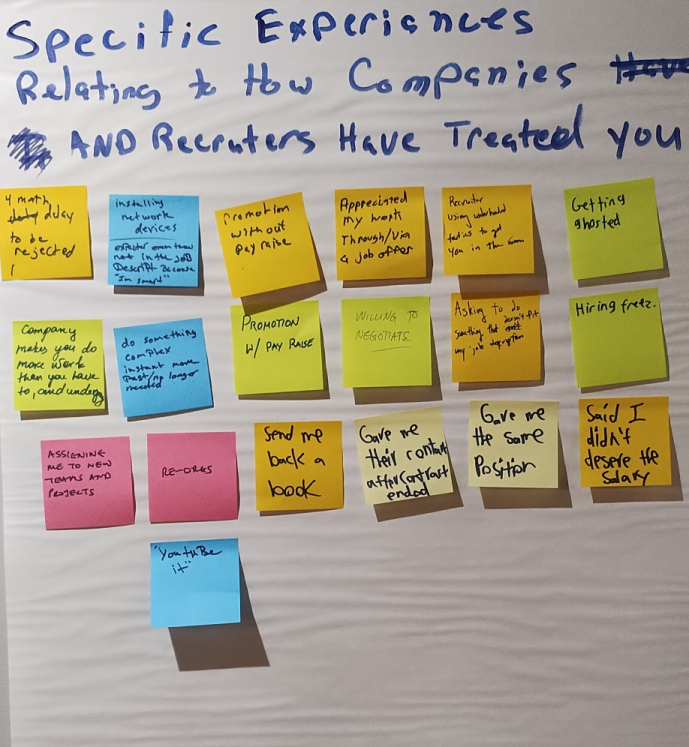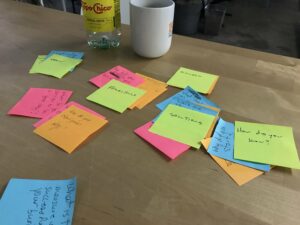The Complexities
I was driving not too long ago, tuned in to NPR, when I heard Erik Brynjolfsson from the Stanford Digital Economy Lab talking about the future of work. He was clear about one thing: artificial intelligence is going to change our jobs in profound ways—just like automation transformed the industrial Midwest a generation ago.
Some jobs will disappear, others will morph, and brand-new ones will appear in places we might not expect. Erik’s words struck me. He argued that policymakers may be underestimating the scale of disruption, and that “retraining” workers isn’t enough—we need to rethink the very skills that will matter.
That hit home for me here in Central Ohio. IT roles aren’t just changing—they’re evolving. And I wanted to know: what does that evolution feel like to people just getting started in the industry?
So, I decided to host a Free Code Camp Columbus meetup to explore this question together. I framed up the conversation with an interactive presentation (you can find it here: Charting Your Path) and invited new technical minds to weigh in. One of my favorite quotes that shaped our discussion came from Ali, who said:
“Employers are looking for people who can go with the flow, have flexibility in their schedules, and can do more with less. Your skills need to be quantifiable and easily consumable.”
That feels like both a warning and an opportunity.
Table of Contents
What the Presentation Framed
In the Charting Your Path presentation, I laid out the current landscape of technical careers. We looked at layoffs, reorganizations, AI disruption, and burnout. Not to be bleak, but to be realistic: this is the environment today’s workforce is navigating.
Then we explored what agility means in technical roles—not just as a process but as a mindset for adaptability and resilience. I also shared research on what drives high-performing teams: clarity of direction, real collaboration, enabling structures, supportive context, and good coaching.
From there, we shifted toward the evolving technical role. Instead of jobs being “replaced” by AI, I suggested that roles are stretching. Developers are moving toward higher-level skills like architecture, systems thinking, design patterns, ethics, and T-shaped expertise. AI is becoming more of a collaborator than a substitute.
I even introduced the idea of an “AI Orchestrator”—a person who doesn’t just use AI tools but provides vision, oversight, and strategy to ensure they’re applied responsibly.
We also discussed skills that are quickly becoming essential: AI literacy, ethical principles, advanced collaboration, and prompt engineering. Interestingly, studies show AI tools can actually slow down development by nearly 20% because humans are still needed to validate, secure, and contextualize solutions.
The presentation ended with a wide-angle look at career paths—from product management and UX to DevOps, data science, cloud security, and machine learning. And we closed with reflection exercises: what’s your next learning step, who could mentor you, and how does it connect back to your goals?
What We Heard from the Room
The sticky-note exercise that followed produced a lot of insight—raw, unfiltered perspectives from people at the start of their IT careers.
1. The industries are everywhere.
Our attendees rattled off more than two dozen sectors where technical people can make an impact: healthcare, insurance, banking, robotics, logistics, retail, government, even YouTube content creation and gambling. If you thought IT meant “just writing code for a software shop,” think again. Technology has become the connective tissue across every domain in Central Ohio.
2. Validation comes in surprising forms.
For some, success meant “crossing off a complete list” or “learning something new today.” For others, it was the joy of solving a problem that had been stuck for a while, or when a supervisor gave positive feedback. The big takeaway? Achievements aren’t always about grand outcomes—they’re about daily progress, contribution, and the moments where your work lands.
3. Recruiters and companies, and the talent are misaligned.
Here is where the major disconnect can be easily seen and felt. Stories ranged from the frustrating (“ghosted after a four-month delay,” “promotion without a raise,”

“just YouTube it”) to the rewarding (“appreciated my work with a job offer,” “promotion with a pay raise,” “willing to negotiate”). There’s still a gap between how companies view talent and how talent needs to be supported, but also how re are properly preparing our future generations to be “business ready”.
4. People skills matter as much as tech skills.
The sticky notes here could have been pulled straight from any good Agile playbook: patience, expectation setting, listening, empathy, being brief but powerful, helping teammates, even just “bring donuts.” It turns out that surviving—and thriving—in IT isn’t just about mastering algorithms; it’s about knowing how to work with humans.
5. Tips and tricks for survival.
Critical thinking, systems thinking, knowing when to take a break, and not reinventing the wheel came up repeatedly. Yes, SQL and data structures matter, but so does knowing how to manage stress, build a portfolio, and ask for help when you’re stuck.
My Take
So, where does this leave us?
AI is certainly reshaping the technical workforce, but in Central Ohio, I don’t see it as a doomsday scenario. Instead, I see an ecosystem where the boundaries of “tech jobs” are expanding into every industry. The challenge—and the opportunity—is that success now depends on blending technical depth with adaptability, communication, and a willingness to learn.
The disconnect comes with the business need, recruiting, and the talent. People are burned out — in many ways. Many job seekers who are lost in finding a job, or those who are trying to find new talent (or keep old talent) are trying to go about it using the same old ways they did years ago. Guess what — it’s not working anymore.
But here’s where I can put my thought-leader hat on…. The roles that survive and thrive won’t necessarily be the ones tied to specific tools or frameworks. Those are shifting too quickly—today’s hot JavaScript library is tomorrow’s legacy burden. Instead, the differentiators will look more like timeless software development practices, and training AI models to deliver software this way:
-
Writing clean, testable, maintainable code rather than hacking something together to meet a deadline.
-
Using version control effectively (not just “pushing code to GitHub” but truly understanding branching, code review, and collaboration).
-
Designing systems with resilience, security, and scalability in mind instead of chasing shortcuts.
-
Practicing continuous integration and delivery as a mindset, not just a toolchain.
-
Embracing refactoring and technical debt management as ongoing disciplines, not optional luxuries.
Equally important, technical roles will increasingly require connection to the business. That means:
-
Asking “why” before writing a line of code, to make sure what’s being built aligns with business goals.
-
Speaking the language of outcomes—value delivered, risk reduced, customers served—rather than only lines of code written.
-
Partnering with product managers, designers, and even end users to co-create solutions rather than hiding in a silo.
The NPR story reminded me that policymakers are still playing catch-up with these shifts. But the Free Code Camp conversation showed me that the workforce itself is already adapting in grassroots ways: seeking meaning in small wins, building resilience, and learning how to navigate messy recruiting and corporate structures. However, those who are working the old way are going to be left behind.
If I had to sum it up, I’d say this: the technical workforce in Central Ohio is not shrinking—it’s stretching. The roles may look different than they did a decade ago, and AI may accelerate that change, but the core skills of problem-solving, collaboration, and good software craftsmanship will remain at the heart of it.
As Ali said: the future belongs to those who can go with the flow, quantify their impact, and keep learning.
I’d love to hear from others in Central Ohio: what are you seeing in your workplace, and how is your career path shifting as technology and AI reshape the landscape?

